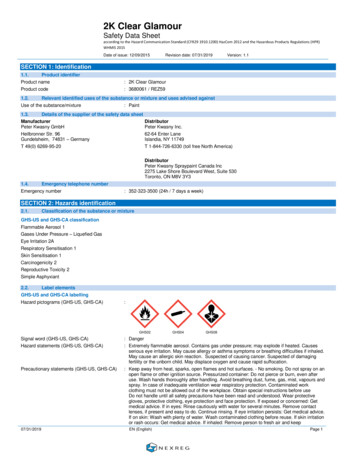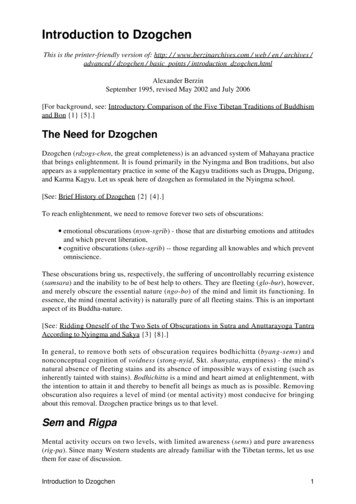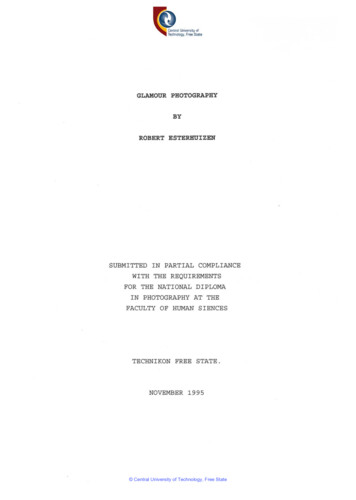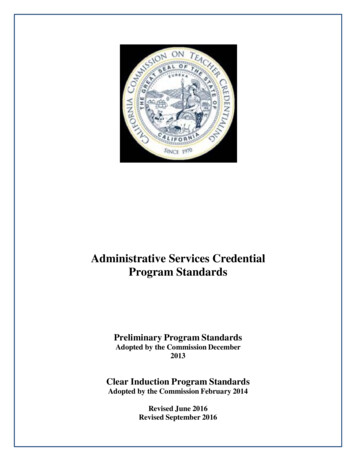
Transcription
2K Clear GlamourSafety Data Sheetaccording to the Hazard Communication Standard (CFR29 1910.1200) HazCom 2012 and the Hazardous Products Regulations (HPR)WHMIS 2015Date of issue: 12/09/2015Revision date: 07/31/2019Version: 1.1SECTION 1: Identification1.1.Product identifierProduct name: 2K Clear GlamourProduct code: 3680061 / REZ591.2.Relevant identified uses of the substance or mixture and uses advised againstUse of the substance/mixture1.3.: PaintDetails of the supplier of the safety data sheetManufacturerPeter Kwasny GmbHDistributorPeter Kwasny Inc.Heilbronner Str. 96Gundelsheim, 74831 – Germany62-64 Enter LaneIslandia, NY 11749T 49(0) 6269-95-20T 1-844-726-6330 (toll free North America)DistributorPeter Kwasny Spraypaint Canada Inc2275 Lake Shore Boulevard West, Suite 530Toronto, ON M8V 3Y31.4.Emergency telephone numberEmergency number: 352-323-3500 (24h / 7 days a week)SECTION 2: Hazards identification2.1.Classification of the substance or mixtureGHS-US and GHS-CA classificationFlammable Aerosol 1Gases Under Pressure – Liquefied GasEye Irritation 2ARespiratory Sensitisation 1Skin Sensitisation 1Carcinogenicity 2Reproductive Toxicity 2Simple Asphyxiant2.2.Label elementsGHS-US and GHS-CA labellingHazard pictograms (GHS-US, GHS-CA):Signal word (GHS-US, GHS-CA): DangerHazard statements (GHS-US, GHS-CA): Extremely flammable aerosol. Contains gas under pressure; may explode if heated. Causesserious eye irritation. May cause allergy or asthma symptoms or breathing difficulties if inhaled.May cause an allergic skin reaction. Suspected of causing cancer. Suspected of damagingfertility or the unborn child. May displace oxygen and cause rapid suffocation.Precautionary statements (GHS-US, GHS-CA): Keep away from heat, sparks, open flames and hot surfaces. - No smoking. Do not spray on anopen flame or other ignition source. Pressurized container: Do not pierce or burn, even afteruse. Wash hands thoroughly after handling. Avoid breathing dust, fume, gas, mist, vapours andspray. In case of inadequate ventilation wear respiratory protection. Contaminated workclothing must not be allowed out of the workplace. Obtain special instructions before useDo not handle until all safety precautions have been read and understood. Wear protectivegloves, protective clothing, eye protection and face protection. If exposed or concerned: Getmedical advice. If in eyes: Rinse cautiously with water for several minutes. Remove contactlenses, if present and easy to do. Continue rinsing. If eye irritation persists: Get medical advice.If on skin: Wash with plenty of water. Wash contaminated clothing before reuse. If skin irritationor rash occurs: Get medical advice. If inhaled: Remove person to fresh air and keepGHS0207/31/2019EN (English)GHS04GHS08Page 1
2K Clear GlamourSafety Data Sheetaccording to the Hazard Communication Standard (CFR29 1910.1200) HazCom 2012 and the Hazardous Products Regulations (HPR) WHMIS 2015comfortable for breathing. If experiencing respiratory symptoms: Call a poison center or doctor.Protect from sunlight. Do not expose to temperatures exceeding 50 C/122 F. Store in a wellventilated place. Store locked up. Dispose of contents and container in accordance with local,regional, national and international regulations.2.3.Other hazardsNo additional information available2.4.Unknown acute toxicity (GHS US, GHS CA)Not applicableSECTION 3: Composition/information on ingredients3.1.SubstanceNot applicable3.2.MixtureNameProduct identifier%Dimethyl ether(CAS No) 115-10-630-60Acetone(CAS No) 67-64-110-30n-Butyl acetateHexamethylene diisocyanate homopolymer(CAS No) 123-86-4(CAS No) 28182-81-27-135-10Xylenes (o-, m-, p- isomers)(CAS No) 1330-20-71-5Propylene glycol monomethyl ether acetate(CAS No) 108-65-60.5-1.5Ethylene glycol monobutyl ether acetate(CAS No) 112-07-20.5-1.5Ethylbenzene(CAS No) 100-41-40.1-1*Chemical name, CAS number and/or exact concentration have been withheld as a trade secretSECTION 4: First aid measures4.1.Description of first aid measuresFirst-aid measures after inhalation: If inhaled, remove to fresh air. If not breathing, give artificial respiration. If breathing is difficult,give oxygen. Get medical attention if condition worsens.First-aid measures after skin contact: In case of contact, immediately flush skin with plenty of water. Remove contaminated clothingand shoes. Wash clothing before reuse. Call a physician if irritation develops and persists.First-aid measures after eye contact: In case of contact, immediately flush eyes with plenty of water for at least 15 minutes. If easy todo, remove contact lenses, if worn. If irritation persists, get medical attention.First-aid measures after ingestion: If swallowed, do NOT induce vomiting unless directed to do so by medical personnel. Nevergive anything by mouth to an unconscious person. Get medical advice/attention if you feelunwell.4.2.Most important symptoms and effects, both acute and delayedSymptoms/injuries after inhalation: May cause respiratory tract irritation. May cause allergy or asthma symptoms or breathingdifficulties if inhaled. Vapours are heavier than air and can cause suffocation by reducingoxygen available for breathing. Symptoms of oxygen deficiency include respiratory difficulty,headache, dizziness, nausea, unconsciousness or death.Symptoms/injuries after skin contact: May cause skin irritation. Symptoms may include redness, drying, defatting and cracking of theskin. May cause an allergic skin reaction.Symptoms/injuries after eye contact: Causes serious eye irritation. Symptoms may include discomfort or pain, excess blinking andtear production, with marked redness and swelling of the conjunctiva.Symptoms/injuries after ingestion: May be harmful if swallowed. May cause stomach distress, nausea or vomiting.4.3.Indication of any immediate medical attention and special treatment neededSymptoms may not appear immediately. In case of accident or if you feel unwell, seek medical advice immediately (show the label or SDS where possible).SECTION 5: Firefighting measures5.1.Extinguishing mediaSuitable extinguishing media: Powder, water spray, foam, carbon dioxide.Unsuitable extinguishing media: Do not use water jet.5.2.Special hazards arising from the substance or mixtureFire hazard: Extremely flammable aerosol. Products of combustion may include, and are not limited to:oxides of carbon, nitrogen oxides, hydrogen cyanide and hydrocarbons.Explosion hazard: Heat may build pressure, rupturing closed containers, spreading fire and increasing risk ofburns and injuries.07/31/2019EN (English)2/2
2K Clear GlamourSafety Data Sheetaccording to the Hazard Communication Standard (CFR29 1910.1200) HazCom 2012 and the Hazardous Products Regulations (HPR) WHMIS 20155.3.Advice for firefightersFirefighting instructions: DO NOT fight fire when fire reaches explosives. Evacuate area.Protection during firefighting: Keep upwind of fire. Wear full fire fighting turn-out gear (full Bunker gear) and respiratoryprotection (SCBA). Use water spray to keep fire-exposed containers cool. Vapours are heavierthan air and may travel considerable distance to an ignition source and flash back to source ofvapours.SECTION 6: Accidental release measures6.1.Personal precautions, protective equipment and emergency proceduresGeneral measures6.2.: Use personal protection recommended in Section 8. Isolate the hazard area and deny entry tounnecessary and unprotected personnel.Methods and material for containment and cleaning upFor containment: Stop leak, if possible without risk. Contain and/or absorb spill with inert material (e.g. sand,vermiculite), then place in a suitable container. Do not flush to sewer or allow to enterwaterways. Use appropriate Personal Protective Equipment (PPE).Methods for cleaning up: Scoop up material and place in a disposal container. Provide ventilation.6.3.Reference to other sectionsSee section 8 for further information on protective clothing and equipment and section 13 for advice on waste disposal.SECTION 7: Handling and storage7.1.Precautions for safe handlingAdditional hazards when processed: Pressurized container: Do not pierce or burn, even after use.Precautions for safe handling: Keep away from sources of ignition - No smoking. Avoid contact with skin and eyes. Avoidbreathing dust/fume/gas/mist/vapours/spray. Do not swallow. When using do not eat, drink orsmoke. Do not spray on an open flame or other ignition source. Use only outdoors or in a wellventilated area.Hygiene measures: Launder contaminated clothing before reuse. Wash hands before eating, drinking, or smoking.7.2.Conditions for safe storage, including any incompatibilitiesTechnical measures: Proper grounding procedures to avoid static electricity should be followed.Storage conditions: Keep out of the reach of children. Do not expose to temperatures exceeding 50 C/ 122 F.Keep in fireproof place. Store away from direct sunlight or other heat sources.Storage area: Store in a well-ventilated place.7.3.Specific end use(s)Not available.SECTION 8: Exposure controls/personal protection8.1.Control parametersDimethyl ether (115-10-6)ACGIHNot applicableOSHANot applicableAcetone (67-64-1)ACGIHACGIH TWA (ppm)250 ppmACGIHACGIH STEL (ppm)500 ppmOSHAOSHA PEL (TWA) (mg/m³)2400 mg/m³OSHAOSHA PEL (TWA) (ppm)1000 ppmIDLHUS IDLH (ppm)2500 ppm (10% LEL)NIOSHNIOSH REL (TWA) (mg/m³)590 mg/m³NIOSHNIOSH REL (TWA) (ppm)250 ppmn-Butyl acetate (123-86-4)ACGIHACGIH TWA (ppm)150 ppmACGIHACGIH STEL (ppm)200 ppmOSHAOSHA PEL (TWA) (mg/m³)710 mg/m³07/31/2019EN (English)3/3
2K Clear GlamourSafety Data Sheetaccording to the Hazard Communication Standard (CFR29 1910.1200) HazCom 2012 and the Hazardous Products Regulations (HPR) WHMIS 2015n-Butyl acetate (123-86-4)OSHAOSHA PEL (TWA) (ppm)150 ppmIDLHUS IDLH (ppm)1700 ppm (10% LEL)NIOSHNIOSH REL (TWA) (mg/m³)710 mg/m³NIOSHNIOSH REL (TWA) (ppm)150 ppmNIOSHNIOSH REL (STEL) (mg/m³)950 mg/m³NIOSHNIOSH REL (STEL) (ppm)200 ppmHexamethylene diisocyanate homopolymer (28182-81-2)ACGIHNot applicableOSHANot applicableXylenes (o-, m-, p- isomers) (1330-20-7)ACGIHACGIH TWA (ppm)100 ppmACGIHACGIH STEL (ppm)150 ppmOSHAOSHA PEL (TWA) (mg/m³)435 mg/m³OSHAOSHA PEL (TWA) (ppm)100 ppmPropylene glycol monomethyl ether acetate (108-65-6)ACGIHNot applicableOSHANot applicableEthylene glycol monobutyl ether acetate (112-07-2)ACGIHACGIH TWA (ppm)20 ppmNIOSHNIOSH REL (TWA) (mg/m³)33 mg/m³OSHANot applicableNIOSHNIOSH REL (TWA) (ppm)5 ppmEthylbenzene (100-41-4)ACGIHACGIH TWA (ppm)20 ppmOSHAOSHA PEL (TWA) (mg/m³)435 mg/m³OSHAOSHA PEL (TWA) (ppm)100 ppmIDLHUS IDLH (ppm)800 ppm (10% LEL)NIOSHNIOSH REL (TWA) (mg/m³)435 mg/m³NIOSHNIOSH REL (TWA) (ppm)100 ppmNIOSHNIOSH REL (STEL) (mg/m³)545 mg/m³NIOSHNIOSH REL (STEL) (ppm)125 ppm8.2.Exposure controlsAppropriate engineering controls: Use ventilation adequate to keep exposures (airborne levels of dust, fume, vapor, etc.) belowrecommended exposure limits.Hand protection: Wear chemically resistant protective gloves.Eye protection: Wear approved eye (properly fitted dust- or splash-proof chemical safety goggles) / face (faceshield) protection.Skin and body protection: Wear suitable protective clothing.Respiratory protection: In case of insufficient ventilation, wear suitable respiratory equipment. Respirator selectionmust be based on known or anticipated exposure levels, the hazards of the product and thesafe working limits of the selected respirator.Environmental exposure controls: Maintain levels below Community environmental protection thresholds.Other information: Do not eat, smoke or drink where material is handled, processed or stored. Wash hands carefullybefore eating or smoking. Handle according to established industrial hygiene and safety practices.07/31/2019EN (English)4/4
2K Clear GlamourSafety Data Sheetaccording to the Hazard Communication Standard (CFR29 1910.1200) HazCom 2012 and the Hazardous Products Regulations (HPR) WHMIS 2015SECTION 9: Physical and chemical properties9.1.Information on basic physical and chemical propertiesPhysical state: Gas/Pressurized LiquidAppearance: ClearColour: No data availableOdour: CharacteristicOdour threshold: No data availablepH: No data availableMelting point: No data availableFreezing point: No data availableBoiling point: Not applicableFlash point: 0 C (32 ⁰F) without propellantRelative evaporation rate (butylacetate 1): No data availableFlammability (solid, gas): FlammableExplosive limits: 1.2% - 18.6%Explosive properties: No data availableOxidising properties: No data availableVapour pressure: 2550.2 mm Hg (340 kPa)Relative densityRelative vapour density at 20 C: 0.75 g/cm³ (20 ⁰C, 68 ⁰F): No data availableDensity: No data availableSolubility: InsolubleLog Pow: No data availableAuto-ignition temperature: 235 C (455 ⁰F)Decomposition temperature: No data availableViscosity: No data availableViscosity, kinematic: No data availableViscosity, dynamic: No data available9.2.Other informationVOC content: 80.66 %SECTION 10: Stability and reactivity10.1.ReactivityNo dangerous reaction known under conditions of normal use.10.2.Chemical stabilityStable under normal storage conditions. Extremely flammable aerosol. Contents under pressure. Container may explode if heated. Do not puncture. Donot burn. Extreme risk of explosion by shock, friction, fire or other sources of ignition.10.3.Possibility of hazardous reactionsNo dangerous reaction known under conditions of normal use.10.4.Conditions to avoidHeat. Sparks. Open flame. Direct sunlight. Overheating. Incompatible materials.10.5.Incompatible materialsOxidizing materials. Acids. Alkalis.10.6.Hazardous decomposition productsMay include, and are not limited to: oxides of carbon, nitrogen oxides, hydrogen cyanide and hydrocarbons.SECTION 11: Toxicological information11.1.Information on toxicological effectsAcute toxicity2K Clear GlamourLD50 oral rat07/31/2019: Not classified. 2000 mg/kgEN (English)5/5
2K Clear GlamourSafety Data Sheetaccording to the Hazard Communication Standard (CFR29 1910.1200) HazCom 2012 and the Hazardous Products Regulations (HPR) WHMIS 20152K Clear GlamourLD50 dermal rabbitLC50 inhalation rat 2000 mg/kg 5 mg/l/4hDimethyl ether (115-10-6)LC50 inhalation rat308.5 mg/l/4hAcetone (67-64-1)LD50 oral ratLC50 inhalation rat5800 mg/kg50100 mg/m³/8hn-Butyl acetate (123-86-4)LD50 oral ratLD50 dermal rabbitLC50 inhalation rat10768 mg/kg 17600 mg/kg390 ppm/4hHexamethylene diisocyanate homopolymer (28182-81-2)LC50 inhalation rat18500 mg/m³/1hXylenes (o-, m-, p- isomers) (1330-20-7)LD50 oral ratLD50 dermal rabbitLC50 inhalation rat3500 mg/kg 4350 mg/kg29.08 mg/l/4hPropylene glycol monomethyl ether acetate (108-65-6)LD50 oral rat8532 mg/kgLD50 dermal rabbit 5 g/kgEthylene glycol monobutyl ether acetate (112-07-2)LD50 oral rat2400 mg/kgLD50 dermal rabbit1480 mg/kgEthylbenzene (100-41-4)LD50 oral ratLD50 dermal rabbitLC50 inhalation rat3500 mg/kg15400 mg/kg17.2 mg/l/4hSkin corrosion/irritation: Based on available data, the classification criteria are not met.Serious eye damage/irritation: Causes serious eye irritation.Respiratory or skin sensitisation: May cause allergy or asthma symptoms or breathing difficulties if inhaled. May cause anallergic skin reaction.Germ cell mutagenicity: Based on available data, the classification criteria are not met.Carcinogenicity: Suspected of causing cancer.Xylenes (o-, m-, p- isomers) (1330-20-7)IARC group3 - Not classifiableEthylbenzene (100-41-4)IARC groupNational Toxicology Program (NTP) Status2B - Possibly carcinogenic to humans1 - Evidence of CarcinogenicityReproductive toxicity: Suspected of damaging fertility or the unborn child.Specific target organ toxicity (single exposure): Based on available data, the classification criteria are not met.Specific target organ toxicity (repeated exposure): Based on available data, the classification criteria are not met.Aspiration hazard: Based on available data, the classification criteria are not met.Symptoms/injuries after inhalation: May cause respiratory tract irritation. May cause allergy or asthma symptoms or breathingdifficulties if inhaled. Vapours are heavier than air and can cause suffocation by reducingoxygen available for breathing. Symptoms of oxygen deficiency include respiratory difficulty,headache, dizziness, nausea, unconsciousness or death.Symptoms/injuries after skin contact: May cause skin irritation. Symptoms may include redness, drying, defatting and cracking of theskin. May cause an allergic skin reaction.Symptoms/injuries after eye contact: Causes serious eye irritation. Symptoms may include discomfort or pain, excess blinking andtear production, with marked redness and swelling of the conjunctiva.07/31/2019EN (English)6/6
2K Clear GlamourSafety Data Sheetaccording to the Hazard Communication Standard (CFR29 1910.1200) HazCom 2012 and the Hazardous Products Regulations (HPR) WHMIS 2015Symptoms/injuries after ingestion: May be harmful if swallowed. May cause stomach distress, nausea or vomiting.SECTION 12: Ecological information12.1.ToxicityEcology - general12.2.: May cause long-term adverse effects in the aquatic environment.Persistence and degradability2K Clear GlamourPersistence and degradability12.3.Not established.Bioaccumulative potential2K Clear GlamourBioaccumulative potential12.4.Not established.Mobility in soilNo additional information available12.5.Other adverse effectsEffect on the global warming: No known ecological damage caused by this product.SECTION 13: Disposal considerations13.1.Waste treatment methodsWaste disposal recommendations: This material must be disposed of in accordance with all local, state, provincial, and federalregulations. The generation of waste should be avoided or minimized wherever possible.Container under pressure. Do not drill or burn even after use.Additional information: Flammable vapours may accumulate in the container.SECTION 14: Transport informationIn accordance with DOT/TDGUN-No.(DOT/TDG): UN1950Proper Shipping Name (DOT/TDG): Aerosols, flammableClass (DOT/TDG): 2.1Hazard labels (DOT/TDG):Additional informationOther information: No supplementary information available.Special transport precautions: Do not handle until all safety precautions have been read and understood.SECTION 15: Regulatory information15.1. Federal regulationsAll components of this product are listed, or excluded from listing, on the United States Environmental Protection Agency Toxic SubstancesControl Act (TSCA) inventory.Acetone (67-64-1)EPA TSCA Regulatory FlagT - T - indicates a substance that is the subject of a Section 4 test rule under TSCAn-Butyl acetate (123-86-4)EPA TSCA Regulatory FlagT - T - indicates a substance that is the subject of a Section 4 test rule under TSCAXylenes (o-, m-, p- isomers) (1330-20-7)Subject to reporting requirements of United States SARA Section 313SARA Section 313 - Emission Reporting1.0 %Ethylbenzene (100-41-4)Subject to reporting requirements of United States SARA Section 313SARA Section 313 - Emission Reporting0.1 %07/31/2019EN (English)7/7
2K Clear GlamourSafety Data Sheetaccording to the Hazard Communication Standard (CFR29 1910.1200) HazCom 2012 and the Hazardous Products Regulations (HPR) WHMIS 2015All components of this product are listed, or excluded from listing, on the Canadian DSL (Domestic Substances List) and NDSL (Non-DomesticSubstances List) inventories.15.2. US State regulations2K Clear GlamourState or local regulationsThis product contains chemicals known to the State of California to cause cancer.SECTION 16: Other informationDate of issue: 07/31/2019Revision date: 07/31/2019Other information: None.Disclaimer: We believe the statements, technical information and recommendations contained herein are reliable, but they are given without warranty or guarantee of any kind. The information containedin this document applies to this specific material as supplied. It may not be valid for this material if it is used in combination with any other materials. It is the user’s responsibility to satisfy oneself as to thesuitability and completeness of this information for the user’s own particular use.07/31/2019EN (English)8/8
GHS-US and GHS-CA labelling Hazard pictograms (GHS-US, GHS-CA) : GHS02 GHS04 GHS08 Signal word (GHS-US, GHS-CA) : Danger Hazard statements (GHS-US, GHS-CA) : Extremely flammable aerosol. Contains gas under pressure; may explode if heated. Causes serious eye irritation. May cause allergy or asthma symptoms or breathing difficulties if inhaled.










